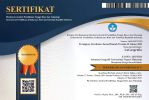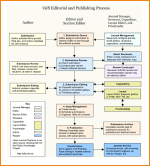The Impact of Reclamation of the Central Point of Indonesia (CPI) Area in Makassar City on the Socioeconomic Conditions of the Community
(1) Program Studi Pendidikan Geografi, Fakultas MIPA, Universitas Negeri Makassar
(2) Program Studi Geografi, Fakultas MIPA, Universitas Negeri Makassarar
(3) Program Studi Pendidikan Geografi, Fakultas MIPA, Universitas Negeri Makassar
(4) Program Studi Pendidikan Geografi, Fakultas MIPA, Universitas Negeri Makassar
(5) Program Studi Geografi, Fakultas MIPA, Universitas Negeri Makassar
(*) Corresponding Author
DOI: https://doi.org/10.35580/lageografia.v21i1.23312
Abstract
This study aims to determine whether the construction of the Center Point Of Indonesia (CPI) affects the socio-economic conditions of the people in the Makassar City sub-district. The independent variable in this study is the construction of the Center Point Of Indonesia (CPI) while the dependent variable is the socio-economic condition of the community. The population in this study is the people of Mariso District, while the sample is 100 people. The type of research used is descriptive quantitative. The sampling technique used is random sampling. The instrument used is a questionnaire with a Likert scale. The results showed that the positive impact of the Center Point Of Indonesia (CPI) development was the availability of employment and many available facilities and infrastructure, while the negative impact was the reduced income of the community, especially fishermen who were looking for catch around the Center Point Of Indonesia (CPI) construction site.
Keywords
Full Text:
PDFReferences
Amir, M. F. (2019). Strategi Bertahan Hidup Buruh Nelayan di Barombong Kec. Tamalate Kota Makassar. LaGeografia, 16(2), 86-93. https://doi.org/10.35580/lga.v16i2.9586
Annas, A., & Rusnaedy, Z. (2019). Evaluasi Kebijakan Tata Ruang dan Bangunan Reklamasi Pantai Metro Tanjung Bunga Kota Makassar. Journal of Government and Civil Society, 3(2), 117-128. https://doi.org/10.31000/jgcs.v3i2.1948
Anugrahini, T. (2018). Resiliensi sosial nelayan Kamal Muara dalam menghadapi dampak reklamasi Teluk Jakarta. Jurnal Penelitian Kesejahteraan Sosial, 17(1), 37-46.
Arikunto, S. (2019). Prosedur penelitian.
Brown, D., Hallman, R. G., Lee, C. R., Skogerboe, J. G., Eskew, K., Price, R. A., Page, N. R., Clar, M., Kort, R., & Hopkins, H. (1986). Reclamation and vegetative restoration of problem soils and disturbed lands. Noyes Data Corporation. Park Ridge, New Jersey
Griffin, A., & James, A. (2018). Humanities Curricula as White Property: Toward a Reclamation of Black Creative Thought in Social Studies & Literary Curricula. Multicultural Education, 25, 10-17.
Hadibasyir, H. Z., Fikriyah, V. N., Sunariya, M. I. T., & Danardono, D. (2020). Pemetaan Kondisi Ekologi Perkotaan Skala Mikro Menggunakan Citra Landsat 8 di Kota Semarang. LaGeografia, 18(3), 209-220. https://doi.org/10.35580/lageografia.v18i3.13476
Harris, J. A., Birch, P., & Palmer, J. P. (1996). Land restoration and reclamation: principles and practice. Addison Wesley Longman Ltd.
Maulana, F. (2022). Sebaran Sedimen Dasar Sebelum dan Setelah Reklamasi Center Point of Indonesia (CPI) Kota Makassar= Bed Sediment Distribution Before and After Reclamation Center Point of Indonesia (CPI) Makassar City. Universitas Hasanuddin.
Muhson, A. (2012). Pelatihan Analisis Statistik dengan SPSS. Yogyakarta: FISE UNY.
Mustaqim, I. (2015). Dampak reklamasi pantai utara jakarta terhadap perubahan sosial ekonomi masyarakat: tinjauan sosiologis masyarakat di sekitaran pelabuhan Muara Angke, Kelurahan Pluit, Jakarta Utara.
Peterson, R., Slovin, J. P., & Chen, C. (2010). A simplified method for differential staining of aborted and non-aborted pollen grains. International Journal of Plant Biology, 1(2), e13. https://doi.org/10.4081/pb.2010.e13
Rasyid, R., Agustang, A. T. P., Robo, T., Aryuni, V. T., & Sudjud, S. (2022). Analisis Karakteristik Lingkungan Permukiman Kumuh di Kelurahan Makassar Timur Kota Ternate. LaGeografia, 20(3), 316-329.
Silalahi, U. (2015). Metode Penelitian Sosial Kuantitatif. Journal of Visual Languages & Computing, 11(3), 287-301.
Sugiyono, P. (2019). Metode Penelitian Pendidikan (Kuantitatif, Kualitatif, Kombinasi, R&D dan Penelitian Pendidikan) (A. Nuryanto (ed.); Ke-3). Alfabeta.
Suhardi, S. (2021). Analysis of the Center Point of Indonesia (CPI) Reclamation Policy of Makassar City in the Environmental Political Perspective. International Journal of Multicultural and Multireligious Understanding, 8(10), 12-23. https://doi.org/10.18415/ijmmu.v8i10.2985
Sujarweni, V. W. (2015). Metodologi penelitian bisnis dan ekonomi.
Wulandari, A. S. R., & HM, M. (2019). Tinjauan Yuridis Reklamasi Pantai dan Implikasinya di Anjungan Pantai Losari Makassar. PETITUM, 7(1 April), 59-80.
Xiao, L. B., Fang, X. Q., & Ye, Y. (2013). Reclamation and revolt: Social responses in eastern Inner Mongolia to flood/drought-induced refugees from the north China plain 1644-1911. Journal of Arid Environments, 88, 9-16. https://doi.org/10.1016/j.jaridenv.2012.07.022
Article Metrics
Abstract view : 194 times | PDF view : 66 timesRefbacks
- There are currently no refbacks.
Copyright (c) 2022 Indra Syamsuddin, Uca Sideng, Ibrahim abbas, Sulaiman Zhiddiq, Amal Arfan

This work is licensed under a Creative Commons Attribution-NonCommercial 4.0 International License.
LaGeografia: Jurnal Program Studi Pendidikan Geografi, Jurusan Geografi, Fakultas MIPA, Universitas Negeri Makassar.
Email: lageografia@unm.ac.id | +6285298749260
Editorial Office














































